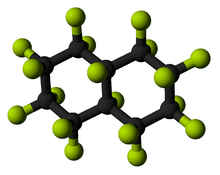Perfluorodecalin
| Perfluorodecalin | ||
|---|---|---|
 |
 | |
| IUPAC name octadecafluorodecalin | ||
| Other names Flutec PP6 | ||
| Identifiers | ||
| CAS number | 306-94-5 | |
| PubChem | 9386 | |
| UNII | 54A06VV62N | |
| Jmol-3D images | {{#if:FC1(F)C(F)(F)C(F)(F)[C@]2(F)C(F)(F)C(F)(F)C(F)(F)C(F)(F)[C@@]2(F)C1(F)F|Image 1 | |
| ||
| Properties | ||
| Molecular formula | C10F18 | |
| Molar mass | 462 | |
| Appearance | Clear, colorless liquid | |
| Density | 1.917 | |
| Boiling point | 142 °C; 288 °F; 415 K | |
| Solubility in water | 10 ppm | |
| Hazards | ||
| Main hazards | None | |
| Flash point | None | |
| Autoignition temperature | None | |
| Except where noted otherwise, data are given for materials in their standard state (at 25 °C (77 °F), 100 kPa) | ||
| Infobox references | ||
Perfluorodecalin (C10F18) is a fluorocarbon, a derivative of decalin in which all of the hydrogen atoms are replaced by fluorine atoms. It is chemically and biologically inert, and stable up to 400°C. Several applications make use of its ability to dissolve gases.
Manufacture
Commercially, perfluorodecalin is manufactured by fluorination with cobalt(III) fluoride (the Fowler process). The preferred starting material is tetralin, having fewer hydrogens than decalin itself (and so requiring less fluorine), and a liquid, unlike naphthalene (so readily handled). For most applications, several steps of purification are required after reaction.
Isomers
Perfluorodecalin exhibits cis-trans isomerism, as the tertiary fluorines atoms on the bridge carbon atoms can be either on the same side as each other (cis-isomer) or on opposite sides (trans-isomer). Both isomers are chemically and biologically inert, and are very similar in their physical properties. The most notable difference is in the melting point, which is -3.6°C for the cis-isomer, +18°C for the trans-isomer, and -6.7°C for a 50/50 mixture.[1]
Medical applications
Of all the perfluorocarbons, perfluorodecalin has probably seen the most interest in medical applications. Most applications utilize its ability to dissolve large amounts of oxygen (100 ml of perfluorodecalin at 25°C will dissolve 49 ml of oxygen at STP[2]).
Perfluorodecalin was an ingredient in Fluosol, an artificial blood product developed by Green Cross Corporation in the 1980s. It is also being studied for use in liquid breathing. Perfluorodecalin can be applied topically, to provide extra oxygen to a specific location, to accelerate wound healing. Organs and tissues can be stored for longer in oxygenated perfluorodecalin; the "two-layer method" uses perfluorodecalin and UW solution to preserve tissue for pancreas transplants.[3]
Other applications
Due to its gas carrying capacity, perfluorodecalin has been used to enhance oxygen delivery during cell culture.[4] Perfluorodecalin has also been shown to dramatically enhance in vivo microscopy resolution of airspace-containing tissues such as mesophyll. Mounting leaves in perfluorodecalin significantly improves the optical qualities of the leaf, thereby enabling high-resolution imaging over twofold deeper into the mesophyll, compared with using water. The physiological impact of mounting the specimen in perfluorodecalin is also minimal compared to water.[5]
This compound is sometimes used to dissolve teflon.[6]
References
- ↑ "Flutec PP Fluorocarbon Liquids", ISC Chemicals Ltd, table E5-2/4
- ↑ "Perfluorodecalin". F2 Chemicals Ltd.
- ↑ For instance, Witkowski, P.; Liu, Z.; Guo, Q.; Poumian-Ruiz, E.; Cernea, S.; Herold, K.; Hardy, M.A. (2005). "Two-Layer Method in Short-Term Pancreas Preservation for Successful Islet Isolation". Transplantation Proceedings 37 (8): 3398–401. doi:10.1016/j.transproceed.2005.09.050. PMID 16298606.
- ↑ King, A. T.; Mulligan, B. J.; Lowe, K. C. (1989). "Perfluorochemicals and Cell Culture". Nature Biotechnology 7: 1037–1042. doi:10.1038/nbt1089-1037.
- ↑ Littlejohn, George R.; Gouveia, João D.; Edner, Christoph; Smirnoff, Nicholas; Love, John (2010). "Perfluorodecalin enhances in vivo confocal microscopy resolution of Arabidopsis thaliana mesophyll". New Phytologist 186 (4): 1018–25. doi:10.1111/j.1469-8137.2010.03244.x. PMID 20374500.
- ↑ "ptfe af". Sigma Aldrich.